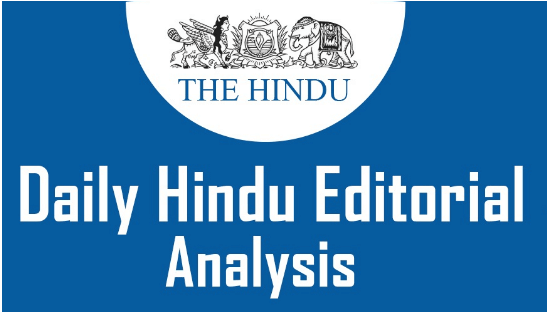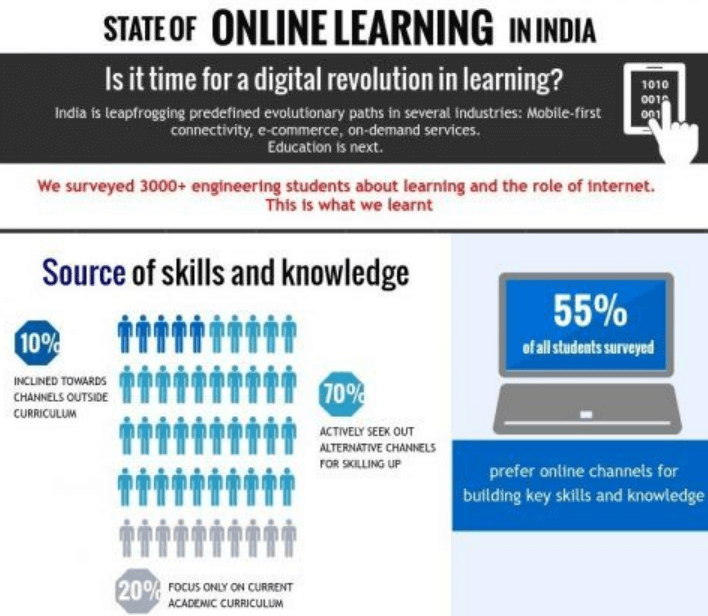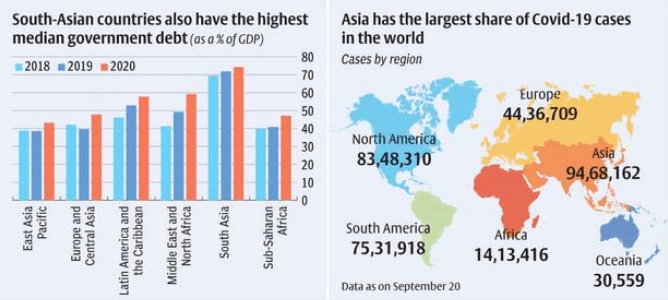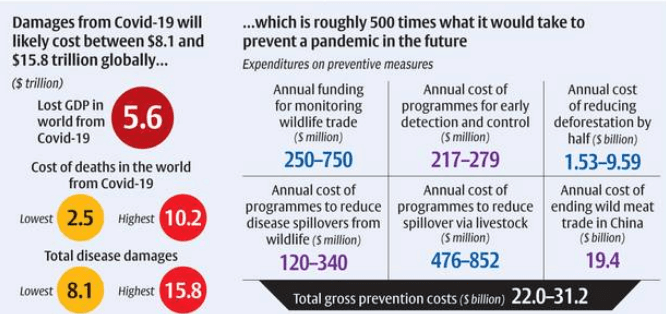The Hindu Editorial Analysis- 23rd Sept, 2020 | Additional Study Material for UPSC PDF Download

1. A NEW WORLD ORDER: ON UN REFORMS-
GS 2- Important International institutions, agencies and fora, their structure, mandate
Context
(i) At a special session marking 75 years of the United Nations on Tuesday, PM called for reform of its “outdated structures”, pointing out that in the absence of comprehensive changes, the world body today faces a “crisis of confidence”.
(ii) While the words appear harsh given the occasion, they can hardly be faulted.
Reforms Imperative
(i) India has been at the forefront of demanding reform in the UN, particularly its principal organ, the Security Council, for decades.
(ii) India stakes its claim as one of the world’s largest economies and most populous countries, with a track record in promoting a rules-based international order, and contributing to peacekeeping through UN forces.
(iii) The UN was born in the crisis of the World War era, and the realities of that time can hardly be compared to the present.
(iv) The UNSC’s permanent, veto-carrying members, chosen by virtue of being “winners” of World War II — the U.S., the U.K., France, Russia and later China — can hardly claim adequate representation of the world’s leadership today.
(v) The UNSC does not include a permanent member from the African, Australian and South American continents.
(vi) And the pillars of the multilateral order, such as the G-4 group of Brazil, India, Germany and Japan, have been ignored for long.
(vii) Other, more representative options exist, and that has been the crux of the battle for change.
(viii) Also, there is a deep polarisation(division) within the UN’s membership, so decisions are either not taken, or not heeded(obliged).
(ix) Frequent divisions within the UNSC P-5 end up blocking key decisions.
(x) These issues are underlined in a year where the coronavirus pandemic has brought the world to a standstill; yet, the UN, the UNSC, and WHO have failed to play an effective role in helping nations deal with the spread.
(xi) For India, what has been most frustrating is that the UN’s reform process, held through Inter Governmental Negotiations (IGN) has not made progress over decades, despite commitments.
(xii) The UN has chosen to “rollover” the discussions of the IGN, which are looking at five major issues.
(xiii) Those issues are- enlarging the Security Council, categories of membership, the question of the veto that five Permanent members of the UNSC wield, regional representation, and redistributing the Security Council-General Assembly power balance.
(xiv) It is some comfort that the UN’s 75th anniversary declaration passed by all member countries this week pledges to “upgrade the United Nations”.
(xv) It is committed to “instil new life in the discussions on the reform of the Security Council”.
(xvi) Those words can only be realised if the UNSC’s permanent members recognise the deep peril(risk) the UN faces and support the reform process.
(xvii) An act that will require looking beyond their own interests for the greater good of the world and its peace-building architecture.
Conclusion
The permanent members of the UNSC must support the reform process of the UN.
2. E-LEARNING IN INDIA, A CASE OF BAD EDUCATION-
GS 2- Issues relating to development and management of Social Sector/Services relating to Education
Context
(i) Equality of opportunity to all is one of the basic principles of our Constitution.
(ii) From an educational point of view, John Dewey, American philosopher, psychologist, and educational reformer, strongly argued that-
“An environment in which some are limited will always in reaction create conditions that prevent the full development even of those who fancy they enjoy complete freedom for unhindered growth.”
(iii) Another point he makes equally strongly is that for good education, one must lead the child’s current interests and abilities organically to logically organised human knowledge.
(iv) This second point is an indicator of the quality of education.

The Key Issues
(i) Our education system was never very efficient even in the best of times. The COVID-19 pandemic has rendered it extremely biased and faulty.
(ii) The main thrust of providing learning opportunities while schools are shut is online teaching.
(iii) There are several sets of guidelines and plans issues by the government, the National Council of Educational Research and Training (NCERT) and the Central Board of Secondary Education (CBSE) for this purpose.
(iv) The Internet space is teeming(filled) with learning schemes, teaching videos, sites and portals for learning opportunities.
(v) The content of all government sites and schemes is primarily the NCERT-issued Alternative Academic Calendar, videos of teaching, digital editions of textbooks, and links to other such material.
(vi) There are three pertinent issues in this whole effort of online education and schemes that need serious consideration.
(vii) One, an exacerbation(worsening) of inequality; two, the pedagogical(teaching) issues leading to bad quality education; and three, an unwarranted thrust on online education, post-COVID-19.
Exacerbation Of Inequality
(i) It is worth repeating a truism that calamities, be they natural or man-made, affect the underprivileged the hardest; COVID-19 is no exception.
(ii) The plight(suffering) of millions of migrant labourers, many of who walked thousands of kilometres right in the beginning of the lockdown, proved the point adequately.
(iii) A similar but less noticed deprivation is being visited to children of the same people, which may push the next generation in a direction of even greater comparative disadvantage.
(iv) In our society there is no large movement that may generate any hope of an improved situation in terms of equality and social justice.
(v) Therefore, any positive change that might come about will be a cumulative result of the development of capabilities and grit in individuals.
(vi) The COVID-19 shutdown has affected this opportunity for the poor even harder than their counterparts from well-to-do sections of society.
(vii) The government began plans for students with no online access only by the end of August. The plans themselves were the usual glib(fluent) talk always served to the poor.
(viii) These plans assume semi-literate or illiterate parents teaching children, community involvement, mobile pools, and so on.
(ix) Anyone with an understanding of rural India will immediately note these to be imaginary.
(x) As a result, whatever online or digital education is available is for students with only online access. Thus, digital India may become even more unequal and divided than it already is.
(xi) Even if one takes it as an emergency measure (that ‘something is better than nothing’) and also accept ‘for some is better than no one’ despite it being against the principle of equal opportunity, the quality of online teaching-learning leaves much to be desired.
(xii) The NCERT declares in its Learning Enhancement Guidelines, or LEG that 60-70% students, teachers and parents consider learning satisfactory.
(xiii) However, its survey asks a single question on the feeling of students using the criteria of ‘joyful to burdensome’.
(xiv) The happiness or otherwise of the student while learning is, of course, important, but it says nothing about the quantum and depth of learning.
(xv) Listening to lectures on the mobile phone, copying from the board where the teacher is writing, frequent disconnections and/or having blurred video/audio can hardly and organically connect the child’s present understanding with the logically organised bodies of human knowledge.
No Focus On Concepts
(i) If one sees videos of teaching mathematics, science, history, and the English language, one can hardly avoid noticing problems with them.
(ii) In the science and mathematics videos, in particular, there are many misconceptions and ambiguities(confusion).
(iii) The emphasis is more on ‘tricks’ to remember for success in an examination than laying the stress on conceptual understanding.
(iv) The government of Delhi also uses videos by the Khan Academy (“a nonprofit with a mission to provide a free, world-class education to anyone, anywhere”).
(v) Many American educators have questioned the quality of teaching and have pointed out inadequate or plainly wrong concepts, particularly in mathematics.
(vi) The secondary students are in a better position still because of their relative independence in learning and possible self-discipline.
(vii) The beginners in the lower primary can get nothing at all from this mode of teaching.
(viii) An example of assumptions in the NCERT’s planning in LEG can be instructive; it is glibly pronounced that “for a child in grade I, the learning outcome — associates words with pictures — can be easily taught with the use of resources available from or at home such as newspapers, food packets, things at home, TV programmes, nature, etc.
(ix) All that will be needed is guidance to the parents.” Well, if it were all that simple, then why are our children not learning to read and write?
(x) Education does not happen in chance encounters with print.
(xi) And this requires help from someone who knows the child as well as understands the objective of education.
(xii) Food packets and newspapers in the hands of even ‘guided’ semi-literate parents will be good enough to present a plan on paper, but will be completely useless for the child’s learning.
The Thrust, Post-Covid-19
(i) IT has been presented as a harbinger(sign) of a revolution in education for more than three decades now.
(ii) However, all reliable studies seem to indicate that Information and Communication Technology (ICT) in the classroom helps in already well functioning systems, and either has no benefits or negative impact in poorly performing systems.
(iii) That does not indicate much hope from IT in our education system.
(iv) The NCERT’s LEG states that “COVID-19 has created a situation which demands transformation in school education... the transaction mechanisms in school education may go through a drastic change.
(v) Therefore, even if the pandemic will get over, its traces will be there and school education needs to remodel itself....”
(vi) It recommends that “alternative modes of education for the whole academic session including Internet-based, radio, podcast, community radio, IVRS, TV DTH Channels, etc.” should be developed.
(vii) This transformation of schools in the current understanding of pedagogy, suitability of learning material and quality of learning provided through IT will further devastate the already inadequate system of school education in the country.
(viii) Of course, IT can be used in a balanced manner where it can help; but it should not be seen as a silver bullet to remedy all ills in the education system.
Conclusion
(i) The importance of an institutional environment cannot be overemphasised when one thinks of online teaching.
(ii) Even when the institutions function sub-optimally, students themselves create an environment that supports their growth morally, socially and intellectually in conversations and interactions with each other.
(iii) The online mode of teaching completely forecloses this opportunity.
(iv) In conclusion, our democracy and public education system have, as usual, left the neediest in the lurch(let down) and are providing bad education to those who matter.
3. UNITING TO COMBAT COVID-19-
GS 2- Bilateral, regional and global groupings and agreements involving India and/or affecting India’s interests
Context
(i) With the pandemic showing no signs of abating(reducing), growth prospects for the world’s fastest-growing region, South Asia, appear grim(serious).
(ii) In April, the World Bank predicted that growth in the region would be 1.8%-2.8% this year.
(iii) Governments in South Asian countries have responded in varying degrees to counter the health and economic crises.
(iv) India resumed its economic activities on a limited scale following a strict lockdown imposed in late March and lasting through April.
(v) Bangladesh, Nepal, Pakistan and Sri Lanka did the same after an extended lockdown.
(vi) Bhutan and the Maldives have managed to largely contain community transmission and avoid prolonged lockdowns due to a higher testing rate.
(vii) This is consistent with the hypothesis that countries that have conducted more tests have been more successful in containing the pandemic.
(viii) According to Worldometer, in South Asia, the Maldives has the highest number of tests per million population followed by Bhutan.
(ix) Countries facing a surge in cases, such as India, could have flattened the curve by increasing the number of tests.




Low Mortality
(i) India has the second largest number of COVID-19 cases in the world (over 55 lakh) after the U.S. Bangladesh has around 3.5 lakh cases.
(ii) Surprisingly, unlike other regions, South Asian countries are experiencing a lower mortality(death) rate despite having a higher infection rate.
(iii) Many have suggested that this could be due to the region’s tropical climate, protection offered by a tuberculosis vaccine (BCG), exposure to malaria, and a weaker strain of the virus.
(iv) However, epidemiological studies and the World Health Organization’s reviews have been sceptical about the hypotheses which leave out one plausible(valid) explanation — the concern over data reliability.
(v) Many have suggested that in a region that houses one-fourth of the global population and one-third of the global poor, many COVID-19 deaths might have gone unnoticed, unreported or even under-reported.
The Efficacy Of State Responses
(i) While India, Pakistan, Bangladesh, and the Maldives have unveiled stimulus packages, the rest are yet to announce any concrete support for their low income and lower-middle income population still suffering from the economic fallout of the crisis.
(ii) In late March, India announced a $22.5 billion relief package to ensure food security and cash transfers to save the livelihoods of an estimated 800 million people living in poverty.
(iii) The Reserve Bank of India (RBI) slashed the repo and reverse repo rate to create liquidity for businesses.
(iv) In early April, Bangladesh announced a stimulus package worth about $8 billion in addition to an earlier $595 million incentive package for export-oriented industries.
(v) In late March, Pakistan unveiled a comprehensive fiscal stimulus package of $6.76 billion. Its central bank also slashed the interest rate.
(vi) In late April, the Maldives government mobilised a $161.8 million emergency fund.
(vii) It also announced a short-term financing facility for the tourism industry.
(viii) Sri Lanka signed an agreement with the RBI for a currency swap worth $400 million to support domestic financial stability.
(ix) In late February, the Afghan government allocated about $25 million to fight COVID-19. In addition, a $100.4 million grant was approved by the World Bank in April to Afghanistan.
(x) Although countries like India and Bangladesh announced financial and material stimulus packages, distribution concerns remain unaddressed.
(xi) For instance, the Open Market Sale in Bangladesh appears ineffective as there is no physical distancing and, in some instances, there is political tampering and poor governance.
(xii) In India, the announcement of the lockdown gave citizens less than four hours to prepare.
(xiii) Hoarding of supplies caused a shortage in the market. The lockdown disrupted supply chains. It was a similar situation in Nepal and Pakistan.
Conclusion
(i) Leaders of the region need to look beyond narrow geopolitical rivalry and come together to work towards a well-coordinated response mechanism.
(ii) A SAARC COVID-19 fund was created following Indian Prime Minister’s call to South Asian leaders, but governments are yet to decide on its modus operandi(way of doing things).
(iii) The region could leverage its existing institutional framework under the umbrella of SAARC to effectively respond to the crisis.
(iv) For instance, SAARC Food Banks could be activated to tackle the imminent regional food crisis, and the SAARC Finance Forum can be activated to formulate a regional economic policy response.
(v) If leaders of the region can’t rise to the occasion even when faced with a common problem that is claiming lives, putting millions out of jobs and crippling economies, when will they?
|
21 videos|562 docs|160 tests
|
FAQs on The Hindu Editorial Analysis- 23rd Sept, 2020 - Additional Study Material for UPSC
| 1. What is the significance of the Hindu Editorial Analysis for UPSC aspirants? |  |
| 2. How can the Hindu Editorial Analysis aid in UPSC exam preparation? |  |
| 3. What are the benefits of reading editorials from The Hindu for UPSC aspirants? |  |
| 4. How can I effectively utilize the Hindu Editorial Analysis for my UPSC preparation? |  |
| 5. Is the Hindu Editorial Analysis a reliable source for UPSC preparation? |  |
















